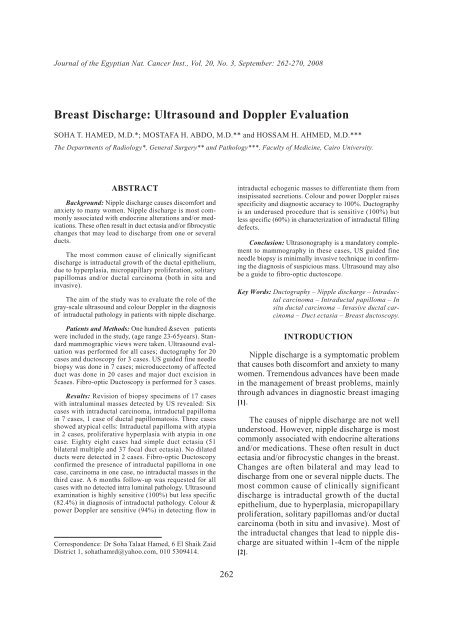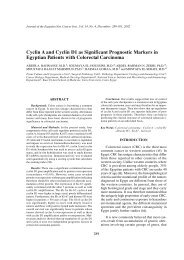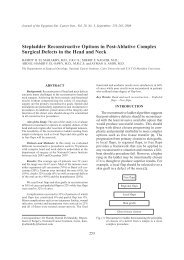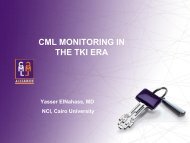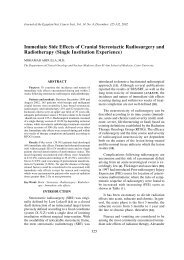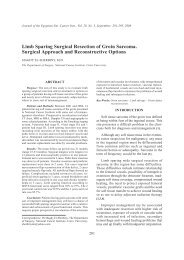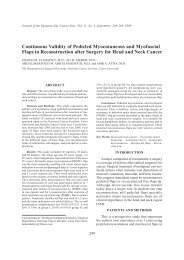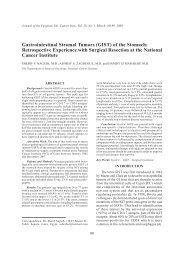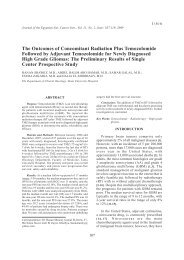Breast Discharge: Ultrasound and Doppler Evaluation - NCI
Breast Discharge: Ultrasound and Doppler Evaluation - NCI
Breast Discharge: Ultrasound and Doppler Evaluation - NCI
You also want an ePaper? Increase the reach of your titles
YUMPU automatically turns print PDFs into web optimized ePapers that Google loves.
Journal of the Egyptian Nat. Cancer Inst., Vol. 20, No. 3, September: 262-270, 2008<br />
<strong>Breast</strong> <strong>Discharge</strong>: <strong>Ultrasound</strong> <strong>and</strong> <strong>Doppler</strong> <strong>Evaluation</strong><br />
SOHA T. HAMED, M.D.*; MOSTAFA H. ABDO, M.D.** <strong>and</strong> HOSSAM H. AHMED, M.D.***<br />
The Departments of Radiology*, General Surgery** <strong>and</strong> Pathology***, Faculty of Medicine, Cairo University.<br />
ABSTRACT<br />
Background: Nipple discharge causes discomfort <strong>and</strong><br />
anxiety to many women. Nipple discharge is most commonly<br />
associated with endocrine alterations <strong>and</strong>/or medications.<br />
These often result in duct ectasia <strong>and</strong>/or fibrocystic<br />
changes that may lead to discharge from one or several<br />
ducts.<br />
The most common cause of clinically significant<br />
discharge is intraductal growth of the ductal epithelium,<br />
due to hyperplasia, micropapillary proliferation, solitary<br />
papillomas <strong>and</strong>/or ductal carcinoma (both in situ <strong>and</strong><br />
invasive).<br />
The aim of the study was to evaluate the role of the<br />
gray-scale ultrasound <strong>and</strong> colour <strong>Doppler</strong> in the diagnosis<br />
of intraductal pathology in patients with nipple discharge.<br />
Patients <strong>and</strong> Methods: One hundred &seven patients<br />
were included in the study, (age range 23-65years). St<strong>and</strong>ard<br />
mammographic views were taken. <strong>Ultrasound</strong> evaluation<br />
was performed for all cases; ductography for 20<br />
cases <strong>and</strong> ductoscopy for 3 cases. US guided fine needle<br />
biopsy was done in 7 cases; microducectomy of affected<br />
duct was done in 20 cases <strong>and</strong> major duct excision in<br />
5cases. Fibro-optic Ductoscopy is performed for 3 cases.<br />
Results: Revision of biopsy specimens of 17 cases<br />
with intraluminal masses detected by US revealed: Six<br />
cases with intraductal carcinoma, intraductal papilloma<br />
in 7 cases, 1 case of ductal papillomatosis. Three cases<br />
showed atypical cells: Intraductal papilloma with atypia<br />
in 2 cases, proliferative hyperplasia with atypia in one<br />
case. Eighty eight cases had simple duct ectasia (51<br />
bilateral multiple <strong>and</strong> 37 focal duct ectasia). No dilated<br />
ducts were detected in 2 cases. Fibro-optic Ductoscopy<br />
confirmed the presence of intraductal papilloma in one<br />
case, carcinoma in one case, no intraductal masses in the<br />
third case. A 6 months follow-up was requested for all<br />
cases with no detected intra luminal pathology. <strong>Ultrasound</strong><br />
examination is highly sensitive (100%) but less specific<br />
(82.4%) in diagnosis of intraductal pathology. Colour &<br />
power <strong>Doppler</strong> are sensitive (94%) in detecting flow in<br />
Correspondence: Dr Soha Talaat Hamed, 6 El Shaik Zaid<br />
District 1, sohathamrd@yahoo.com, 010 5309414.<br />
intraductal echogenic masses to differentiate them from<br />
insipissated secretions. Colour <strong>and</strong> power <strong>Doppler</strong> raises<br />
specificity <strong>and</strong> diagnostic accuracy to 100%. Ductography<br />
is an underused procedure that is sensitive (100%) but<br />
less specific (60%) in characterization of intraductal filling<br />
defects.<br />
Conclusion: Ultrasonography is a m<strong>and</strong>atory complement<br />
to mammography in these cases, US guided fine<br />
needle biopsy is minimally invasive technique in confirming<br />
the diagnosis of suspicious mass. <strong>Ultrasound</strong> may also<br />
be a guide to fibro-optic ductoscope.<br />
Key Words: Ductography – Nipple discharge – Intraductal<br />
carcinoma – Intraductal papilloma – In<br />
situ ductal carcinoma – Invasive ductal carcinoma<br />
– Duct ectasia – <strong>Breast</strong> ductoscopy.<br />
INTRODUCTION<br />
Nipple discharge is a symptomatic problem<br />
that causes both discomfort <strong>and</strong> anxiety to many<br />
women. Tremendous advances have been made<br />
in the management of breast problems, mainly<br />
through advances in diagnostic breast imaging<br />
[1].<br />
The causes of nipple discharge are not well<br />
understood. However, nipple discharge is most<br />
commonly associated with endocrine alterations<br />
<strong>and</strong>/or medications. These often result in duct<br />
ectasia <strong>and</strong>/or fibrocystic changes in the breast.<br />
Changes are often bilateral <strong>and</strong> may lead to<br />
discharge from one or several nipple ducts. The<br />
most common cause of clinically significant<br />
discharge is intraductal growth of the ductal<br />
epithelium, due to hyperplasia, micropapillary<br />
proliferation, solitary papillomas <strong>and</strong>/or ductal<br />
carcinoma (both in situ <strong>and</strong> invasive). Most of<br />
the intraductal changes that lead to nipple discharge<br />
are situated within 1-4cm of the nipple<br />
[2].<br />
262
<strong>Breast</strong> <strong>Discharge</strong>: <strong>Ultrasound</strong> & <strong>Doppler</strong> <strong>Evaluation</strong><br />
<strong>Ultrasound</strong> is an indispensable complementary<br />
diagnostic tool in the investigation of breast<br />
abnormalities. <strong>Ultrasound</strong> is not typically used<br />
unless the nipple discharge is accompanied by<br />
a palpable mass or a positive mammographic<br />
finding. <strong>Ultrasound</strong> may be useful in presurgical<br />
localization if galactography reveals a dilated<br />
duct larger than a few millimeters in width.<br />
Modern high-resolution <strong>Ultrasound</strong> techniques<br />
are becoming more sensitive for the visualization<br />
of intraductal changes. Tiny solitary papillomas<br />
can sometimes be visualized by using this sophisticated<br />
technology [3].<br />
The aim of the study was to evaluate the<br />
role of the gray-scale ultrasound <strong>and</strong> colour<br />
<strong>Doppler</strong> in the diagnosis of intraductal pathology<br />
in patients with nipple discharge.<br />
PATIENTS AND METHODS<br />
One hundred <strong>and</strong> seven patients were included<br />
in the study, their mean age 42±13<br />
years <strong>and</strong> their ages ranged between 23 <strong>and</strong><br />
65 years. Mammograms were performed for<br />
all cases using "Siemens Mammomat Mammography<br />
Unit". Cranio-caudal, mediolateral<br />
<strong>and</strong> oblique views were performed for both<br />
breasts. A range of 25-28 KVP <strong>and</strong> 30-60 MAS<br />
were used. Mammograms were fully inspected<br />
to assess the parenchyma density <strong>and</strong> pattern,<br />
the presence or absence of associated mass<br />
lesions <strong>and</strong> calcifications <strong>and</strong> each was analyzed<br />
individually. The skin thickness, the<br />
condition of nipple areola complex <strong>and</strong> associated<br />
lymphadenopathy were also reported.<br />
In addition to mammography, Ductography<br />
was performed for 20 cases. The nipple was<br />
inspected to identify the orifice of secretion,<br />
After the nipple is sterilized, a ductography<br />
cannula (i.e., a needle with a blunt end) was<br />
gently inserted into the secreting orifice; Approximately<br />
0.2-0.8mL of water-soluble contrast<br />
material is slowly injected by using a 1-<br />
or 3-mL syringe.<br />
<strong>Ultrasound</strong> was performed for all patients<br />
with an Ultramark Philips HDI 5000, Siemens<br />
Sonoline Elegra, voluson 730 machines using<br />
a 7-10MHz linear transducer. The region to be<br />
examined extends from the clavicle above to<br />
the infra-mammary fold below <strong>and</strong> from the<br />
sternum medially to the mid-axillary line laterally.<br />
The axilla <strong>and</strong> supraclavicular regions<br />
263<br />
were also carefully scanned for lymph node<br />
enlargement. A special technique was applied<br />
to examine the retroareolar region by applying<br />
excessive gel on the nipple with gentle pressure<br />
for better visualization of the retroareolar ducts.<br />
The dilated duct was traced throughout its<br />
whole length. Whenever any intraductal lesion<br />
is seen, we should calculate how far it is from<br />
the nipple. This should be followed by 3D<br />
application which allows better lesion delineation<br />
<strong>and</strong> Color <strong>and</strong> power <strong>Doppler</strong> evaluation<br />
to characterize lesion vascularity <strong>Ultrasound</strong><br />
guided fine needle biopsy was performed for<br />
7 cases.<br />
In three cases ductoscopy was performed:<br />
Short term anesthetic was administered, the<br />
nipple was scrubbed <strong>and</strong> rapped; the breast was<br />
deeply massaged from periphery to the center,<br />
as if expressing milk at lactation. The target<br />
duct (fluid-yielding duct) was identified by<br />
manual compression of the individual lactiferous<br />
sinuses. The duct was dilated using the dilators<br />
of lactiferous duct then the ductoscope was<br />
inserted (Fig. 1).<br />
Criteria of lesion assessment:<br />
• Intraductal papillomas: Are mostly oval in<br />
shape, hypo to isoechoic in echopattern, with<br />
smooth margins. A vascular stalk or minimal<br />
peripheral vascularity is usually identified on<br />
<strong>Doppler</strong> application.<br />
• Intraductal papilloma with atypia: Showed<br />
higher vascularity than papillomas. The vessels<br />
are arranged in haphazard distribution.<br />
• Malignant intraductal lesions: Appeared less<br />
uniform with corresponding malignant microcalcification<br />
seen on mammography films.<br />
On colour <strong>Doppler</strong>, malignant lesion showed<br />
higher vascularity, non tapering r<strong>and</strong>omly<br />
dispersed vessels except in small mass lesions.<br />
• Simple duct ectasia: Appeared on mammography<br />
as tubular or diffuse retroareolar increased<br />
density. On ultrasound they appeared<br />
as dilated thin walled ducts (caliber >3mm),<br />
some showed mobile echogenic secretions<br />
that are not adherent to the duct walls, others<br />
revealed inspissated ball like echogenic secretions.<br />
No colour was detected on <strong>Doppler</strong><br />
application.
264<br />
RESULTS<br />
One hundred <strong>and</strong> seven patients, their mean<br />
age 42±13 years <strong>and</strong> their ages ranged between<br />
23 <strong>and</strong> 65 years, presenting either by uniorifical<br />
breast discharge (54 cases) or multi orifice<br />
discharge (one of them with bloody or serosanguous<br />
discharge) (53 cases) (Table 1). Duct<br />
ectasia was the predominant pathology, identified<br />
in 88 cases, their ages range 23-53 years,<br />
with mean age 33.8±11.6 years. While intraductal<br />
mass lesions were identified in only 17<br />
cases, their ages ranging between 27-65 years,<br />
with mean age: 45±12 years. Two cases were<br />
normal.<br />
<strong>Ultrasound</strong> proved to have 100% <strong>and</strong> 82.4%<br />
sensitivity <strong>and</strong> specificity in differentiating<br />
intraductal mass from non mass lesions, namely<br />
inspissated secretions <strong>and</strong> in identifying the<br />
benign or malignant nature of these masses.<br />
Colour <strong>and</strong> power <strong>Doppler</strong> raises specificity<br />
<strong>and</strong> diagnostic accuracy to 100%.<br />
The mean size of papillomas was (8.7±<br />
4.3mm). They lied within 3.2±2.1cm from the<br />
nipple. They all fulfilled the above described<br />
criteria with the exception of two papillomas<br />
with rather irregular outline (Fig. 2). A vascular<br />
stalk could be identified in 4 cases <strong>and</strong> minimal<br />
peripheral vascularity in 3 cases (Fig. 3), Ductoscopy,<br />
performed for 1 case, confirmed the<br />
site <strong>and</strong> size of the ultrasound detected papilloma<br />
(Fig. 4). 3D US was performed confirming the<br />
intraductal location of a lesion (Fig. 5).<br />
The intraductal papillomas showing atypia<br />
measured 5 <strong>and</strong> 11mm, being located between<br />
12 <strong>and</strong> 27mm from the nipple respectively. They<br />
showed higher vascularity than papillomas, the<br />
vessels are arranged in haphazard distribution<br />
(Fig. 6). The case proved to be ductal hyperplasia<br />
with atypia, was discovered during annual<br />
follow-up for fibrocystic breast changes, an<br />
intraductal mass 5mm is seen 27mm from the<br />
nipple (Fig. 7).<br />
<strong>Ultrasound</strong> was complementary to mammography<br />
in identifying malignant intraductal lesions,<br />
one case proved to be invasive ductal<br />
carcinoma, on mammography it was reported<br />
as BIRADS 3, on ultrasound an intraductal mass<br />
with wall irregularity was seen, microcalcification<br />
are seen within the mass but obscured on<br />
Soha T. Hamed, et al.<br />
mammogram by lobulated dilated duct (Fig. 8).<br />
Other masses were ranging in size 4-14mm, no<br />
definite ductal dilatation was seen in two of<br />
them. On colour <strong>Doppler</strong>, malignant lesion<br />
showed higher vascularity, non tapering r<strong>and</strong>omly<br />
dispersed vessels except in small 4mm<br />
mass.<br />
Simple duct ectasia was identified in 88<br />
cases according to the above described criteria.<br />
Mammography showed tubular retroareolar<br />
density in 8 cases, in the rest of cases, there<br />
was just an increase in retroareolar density; By<br />
US In 51 cases, bilateral dilated thin walled<br />
ducts are ranging in caliber from 3-8mm, some<br />
of the ducts showed Intra-ductal mobile, non<br />
adherent movable echogenic secretions were<br />
sometimes identified. In two cases, echogenic<br />
ball like lesions were identified resembling<br />
intraductal pappilomas, yet, they were non<br />
adherent to the wall <strong>and</strong> no colour flow could<br />
be detected on <strong>Doppler</strong> application (Fig. 9).<br />
The ducts were completely normal on both<br />
ultrasound <strong>and</strong> galactography in two cases.<br />
Ductography was requested in 20 cases, in<br />
five cases, intraductal filling defects were seen<br />
three cases proved to be intraductal mass lesions,<br />
other two cases were inssipisated secretions<br />
with no malignancy. Ductography showed 100%<br />
sensitivity <strong>and</strong> 60% specificity in diagnosing<br />
intraductal filling defect.<br />
Table (1): Pathological diagnosis of uni-orificial discha.<br />
Pathological diagnosis<br />
Intraductal carcinoma<br />
Intraductal papilloma<br />
(including intraductal<br />
papillomatosis, one case)<br />
Intra ductal papilloma/<br />
hyperplasia with atypia<br />
Localized duct ectasia<br />
Bilateral diffuse duct ectasia<br />
Normal<br />
Total<br />
No. of cases %<br />
6 (5.6%)<br />
8 (7.5%)<br />
3 (2.8%)<br />
37 (35%)<br />
51 (47.7%)<br />
2 (1.8%)<br />
107 (100%)
<strong>Breast</strong> <strong>Discharge</strong>: <strong>Ultrasound</strong> & <strong>Doppler</strong> <strong>Evaluation</strong><br />
265<br />
(A)<br />
Fig. (1): Technique of ductoscope. A- Dilatation of the duct. B- Insertion of the ductoscope.<br />
(B)<br />
(A)<br />
Fig. (2): 54 year - old female presenting with bilateral breast discharge & left uniorificial bleeding. A. US revealed bilateral<br />
duct ectasia with an exceptionally dilated duct (9mm in caliber) located at 9 o’clock in the right retroareolar<br />
region. Two irregular masses isoechoic to breast parenchyma, the largest (6x3mm) are seen about 1.2cm away<br />
from the nipple (arrows). B. Power <strong>Doppler</strong> application showed a central vascular stalk in the larger lesion.<br />
Diagnosis of intraductal papilloma was confirmed by both FNAB <strong>and</strong> post duct excision revision of the pathology<br />
specimen.<br />
(B)<br />
(A)<br />
Fig. (3): Two different cases of intraductal papillomas presenting by uni orificial bloody nipple discharge. Both lesions<br />
appeared isoechoic. A. Mass was seen 2.8cm from the nipple. B. A central vascular stalk was identified on Power<br />
<strong>Doppler</strong>. Diagnosis was confirmed after FNAB.<br />
(B)
266<br />
Soha T. Hamed, et al.<br />
(A)<br />
(B)<br />
Fig. (4): 50 years old female, with single uniorificial bleeding. A- Gray scale US to the left showed hypoechoic intraductal<br />
mass with cresentic hypoechoic outline in the periphery insuring intraductal site (curved arrow), to right of image<br />
colour <strong>Doppler</strong> showed vascularity inside maintaining benign characters. B- The intraductal papilloma seen on<br />
ductoscopy image.<br />
(A)<br />
Fig. (5): 40 years old female presenting by bleeding per nipple. A- An intraductal mass with rather microlobulated outline<br />
is seen sagging from anterior upper wall of the duct. B- Surface rendering 3D US of intraductal mass.<br />
(B)<br />
(A)<br />
Fig. (6): 35 years old female presenting by right uniorificial bleeding. A- US examination showed an isoechoic mass with<br />
lobulated outline. B- Colour <strong>Doppler</strong> showed high vascularity with irregular distribution. Pathological diagnosis<br />
was intraductal papilloma with atypia.<br />
(B)
<strong>Breast</strong> <strong>Discharge</strong>: <strong>Ultrasound</strong> & <strong>Doppler</strong> <strong>Evaluation</strong><br />
267<br />
(A)<br />
(B)<br />
Fig. (7): 35 years old female with long history of breast discharge &developed uniorificial bleeding. A- A small mass with<br />
ill defined outline is seen with proximal ductal dilatation. B- On colour <strong>Doppler</strong> a small vascular stalk is seen.<br />
Pathology was florid ductal hyperplasia with focal atypia.<br />
(A)<br />
(B)<br />
(C)<br />
(D)<br />
Fig. (8): Forty years old female with right uniorficial sero-sanginous discharge. A- Mammogram mediolateral view<br />
revealed retroarelar rather well circumscribed macro-lobulated mass(arrow). B- Radial US image showed an<br />
irregular intraductal mass (arrows) & microcalcifications (arrow head). C- On colour <strong>Doppler</strong> non tapering<br />
vascular stalk is seen. D- Ductoscopy image showed irregular intraductal mass.
268<br />
Soha T. Hamed, et al.<br />
(A)<br />
(B)<br />
Fig. (9): Forty years old female with uniorificial discharge. A- Galactography revealed two small intraductal filling<br />
defects (arrow). B- US revealed multiple echogenic rounded lesions separable from the wall, no flow inside.<br />
DISCUSSION<br />
Nipple discharge disorders is a field in which<br />
there has been both increasing awareness on<br />
the part of patients <strong>and</strong> advances in management<br />
[4].<br />
In this study in five cases the only finding<br />
seen in galactography was intraductal filling<br />
defects. In dedicated study done by cho <strong>and</strong> his<br />
colleagues ,they stated that in order to thoroughly<br />
<strong>and</strong> accurately evaluate patients exhibiting<br />
pathologic nipple discharges, it is important to<br />
perform ductography <strong>and</strong> not to miss the subtle<br />
but suspicious ductographic findings associated<br />
with breast cancer. Diffusely spreading intraductal<br />
cancers, with or without focal invasions,<br />
are often found to be negative by mammography<br />
(especially in absence of microcalcifications)<br />
<strong>and</strong> sonography. In such cases, ductography<br />
constitutes the best imaging method, as it has<br />
proven effective in the determination of the<br />
nature <strong>and</strong> extent of such lesions <strong>and</strong> can facilitate<br />
appropriate surgical management [5].<br />
We agree with other radiologists who maintain<br />
that ductography is prohibitively timeconsuming<br />
<strong>and</strong> that it can be replaced, at least<br />
in part, by sonography. Intraductal papillary<br />
lesions are sometimes visualized as isoechoic<br />
or hyperechoic masses in dilated ducts on sonography<br />
<strong>and</strong> can often be biopsied under sonographic-guidance<br />
[6-8].<br />
The quality of breast US is closely related<br />
to the performance of the equipment used for<br />
the examination <strong>and</strong> the skill of the examiner.<br />
Linear-array, broad-b<strong>and</strong>width transducers with<br />
maximum frequencies of 10-13MHz <strong>and</strong> a center<br />
frequency of at least 7 or 7.5MHz are required<br />
to depict Ductal carcinoma in situ<br />
(DCIS). The adjustment of focal zones, system<br />
gain <strong>and</strong> time gain compensation setting is also<br />
important. US should be performed in radial<br />
<strong>and</strong> anti-radial planes as well as longitudinal<br />
<strong>and</strong> transverse planes. In patients with DCIS,<br />
radial US is particularly useful for depicting<br />
intraductal masses <strong>and</strong> evaluating the ductal<br />
extent of disease, whereas anti-radial US is<br />
more helpful for evaluating the surface characteristics<br />
of the mass [9]. We add to perfect US<br />
technique for assessment of retroareolar area,<br />
excessive gel <strong>and</strong> gentle pressure to see mass<br />
inside the duct.<br />
Cancer risk from nipple discharge is reported<br />
to be anywhere from 1.3% to 47% [10]. The<br />
incidence of malignancy in this study was 5.6%<br />
in addition to 2.8% precancerous condition<br />
likely hyperplasia <strong>and</strong> atypia.<br />
In this study, masses of intraductal carcinoma<br />
are relatively hypoechoic compared to benign<br />
cases, this coincides with those who reported<br />
that ultrasound appearance of non-screening<br />
detected intraductal carcinoma is relatively<br />
isoechoic in comparison with invasive carcinoma<br />
[10], regarding shape; oval shaped masses<br />
proved in this study to be papillomas but assessment<br />
of margins, was not a point of differentiation,<br />
as in two cases of atypia which showed<br />
macro-lobulated outline <strong>and</strong> in two cases of
<strong>Breast</strong> <strong>Discharge</strong>: <strong>Ultrasound</strong> & <strong>Doppler</strong> <strong>Evaluation</strong><br />
papilloma irregular outline was encountered.<br />
Other authors reported that An oval or lobulated<br />
shape was found more frequently in intraductal<br />
carcinoma than in invasive carcinomas [11].<br />
In malignant cases diagnosed in this study,<br />
no microcalcification could be seen in mammography<br />
even in the case of invasive duct<br />
carcinoma. The microcalcifications were obscured<br />
by dilated duct proximal to mass. Mammographic<br />
detection of DCIS lesions without<br />
microcalcifications may be quite difficult, especially<br />
in dense breasts. At US, most DCIS<br />
lesions without calcifications manifest as single<br />
or multiple hypoechoic masses without a<br />
pseudocapsule. Ductal extension is sometimes<br />
seen. It is easier to visualize noncalcified DCIS<br />
lesions than calcified DCIS lesions at US because<br />
of their hypoechogenicity, but they can<br />
also be misinterpreted as benign nodules due<br />
to their roundness <strong>and</strong> well-circumscribed margins.<br />
Posterior acoustic enhancement may be<br />
seen in large masses. DCIS lesions without<br />
calcifications may manifest as a solid or cystic<br />
mass with solid component [12]. Diagnosis of<br />
non-calcified DCIS by mammography is not an<br />
easy task due to the lack of typical malignant<br />
calcifications or masses. High resolution ultrasound<br />
can be useful for detecting non-calcified<br />
DCIS [13].<br />
In the study of Yang <strong>and</strong> TSI in 2004, Color<br />
power <strong>Doppler</strong> sonography revealed a positive<br />
signal in 22 (69%) of 32 patients in whom it<br />
was performed, so they concluded that it is not<br />
discriminating feature [14]. In the contrary, in<br />
our study all cases with intraductal masses<br />
showed different pattern of vascularity. So it<br />
was highly sensitive <strong>and</strong> specific (100%) in<br />
discriminating between solid masses <strong>and</strong> inspissated<br />
secretions. Vessel arrangement helped in<br />
differentiating benign from malignant masses.<br />
In this study, ultrasound guided ductoscopy<br />
in three cases facilitated lesion delineation. The<br />
size of the mass <strong>and</strong> its distance from the nipple<br />
was comparable. Mammary endoscopy (ductoscopy)<br />
is a recently introduced technique, which<br />
may allow more precise identification <strong>and</strong> delineation<br />
of intraductal disease but is not currently<br />
a st<strong>and</strong>ard practice among most surgeons.<br />
Ductoscopy has been reported to result in improved<br />
localization of intraductal lesions [15].<br />
269<br />
We concluded that ultrasound examination<br />
is highly sensitive(100%) but less specific<br />
(82.4%) in diagnosis of intraductal pathology.<br />
Colour & power <strong>Doppler</strong> are sensitive (94%)<br />
in detecting flow in intraductal echogenic masses<br />
to differentiate them from insipissated secretions.<br />
Colour & power <strong>Doppler</strong> raises specificity<br />
<strong>and</strong> diagnostic accuracy to 100%. Ultrasonography<br />
is a m<strong>and</strong>atory complement to mammography<br />
in these cases. US guided fine needle<br />
biopsy is minimally invasive technique in confirming<br />
the diagnosis of suspicious mass. <strong>Ultrasound</strong><br />
may also be a guide to fibro-optic ductoscope.<br />
Ductography is an underused procedure<br />
that is sensitive (100%) but less specific (60%)<br />
in characterization of intraductal filling defects.<br />
REFERENCES<br />
1- Azavedo E. <strong>Breast</strong>, Nipple <strong>Discharge</strong> <strong>Evaluation</strong>. e<br />
Medicine specialties. Radiology. <strong>Breast</strong> 10 June. 2005.<br />
2- Baker KS, Davey DD, Stelling CB. Ductal abnormalities<br />
detected with galactography: Frequency of adequate<br />
excisional biopsy. AJR Am J Roentgenol. 1994,<br />
Apr 162 (4): 821-4.<br />
3- Shalmali Pal. <strong>Ultrasound</strong> continues to make inroads<br />
in breast imaging, Aunt Minnie.com. <strong>Ultrasound</strong><br />
digital community. 2/6/2007.<br />
4- Okazaki A, Hirata K, Okazaki M, Svane G, Azavedo<br />
E. Nipple discharge disorders: Current diagnostic<br />
management <strong>and</strong> the role of fiber-ductoscopy. European<br />
Radiology. 1999, 9 (4): 583-590.<br />
5- Cho N, Moon WK, Chung SY, Cha JH, Cho KS, Kim<br />
EK, et al. Ductographic Findings of <strong>Breast</strong> Cancer.<br />
Korean Journal of Radiology. 2005, March 6 (1): 31-<br />
36.<br />
6- Stavros AT. Non targeted indications: <strong>Breast</strong> secretions,<br />
nipple discharge, <strong>and</strong> intraductal papillary lesions of<br />
the breast. In: Stavros AT, ed. <strong>Breast</strong> ultrasound, 1 st<br />
ed. Philadelphia, Pa: Lippincott Williams & Wilkins.<br />
2004, 157-198.<br />
7- Moon WK, Myung JS, Lee YJ, Park IA, Noh DY, Im<br />
JG. US of ductal carcinoma in situ. RadioGraphics.<br />
2002, 22: 269-280.<br />
8- Chung SY, Lee KW, Park KS, Lee Y, Bae SH. <strong>Breast</strong><br />
tumors associated with nipple discharge. Correlation<br />
of findings on galactography <strong>and</strong> sonography. Clin<br />
Imaging. 1995, 19: 165-171.<br />
9- Stavros AT, Thickman D, Rapp CL, Dennis MA,<br />
Parker SH, Sisney GA. Solid breast nodules: Use of<br />
sonography to distinguish between benign <strong>and</strong> malignant<br />
lesions. Radiology. 1995, 196: 123-134.<br />
10- Nelson S, Hoehn JL: Twenty-Year Outcome Following<br />
Central Duct Resection for Bloody Nipple <strong>Discharge</strong>.<br />
Ann Surg. 2006, April 243 (4): 522-524.
270<br />
Soha T. Hamed, et al.<br />
11- Chen S-C, Cheung Y-C, Lo Y-F, Chen M-F, Hwang<br />
T-L, Su C-H, et al. Sonographic differentiation of<br />
invasive <strong>and</strong> intraductal carcinomas of the breast.<br />
British Journal of Radiology. 2003, 76: 600-604.<br />
12- Moon WK, Myung JS, Lee YJ, Park IN, Noh DY, Im<br />
YG. US of Ductal Carcinoma In Situ. Radiographics.<br />
2002, 22: 269-281.<br />
13- Cho KR, Seo BK, Kim CH, Whang KW, Kim YH,<br />
Kim BH, et al. Non-Calcified Ductal Carcinoma in<br />
Situ: <strong>Ultrasound</strong> <strong>and</strong> Mammographic Findings Correlated<br />
with Histological Findings. Yonsei Med J. 2008,<br />
49 (1): 103-110.<br />
14- Yang WT, Tse GM. K. Sonographic, Mammographic<br />
<strong>and</strong> Histopathologic Correlation of Symptomatic<br />
Ductal Carcinoma In Situ AJR. 2004, 182: 101-110.<br />
15- Moncrief RM, Nayar R, Diaz LK, Staradub VL,<br />
Morrow M, Khan SA. A Comparison of Ductoscopy-<br />
Guided <strong>and</strong> Conventional Surgical Excision in Women<br />
With Spontaneous Nipple <strong>Discharge</strong>. Ann Surg. 2005,<br />
April 241 (4): 575-581.


